MERCEDES-BENZ SPRINTER 2011 MY11 Operator’s Manual
Manufacturer: MERCEDES-BENZ, Model Year: 2011, Model line: SPRINTER, Model: MERCEDES-BENZ SPRINTER 2011Pages: 292, PDF Size: 6.75 MB
Page 271 of 292
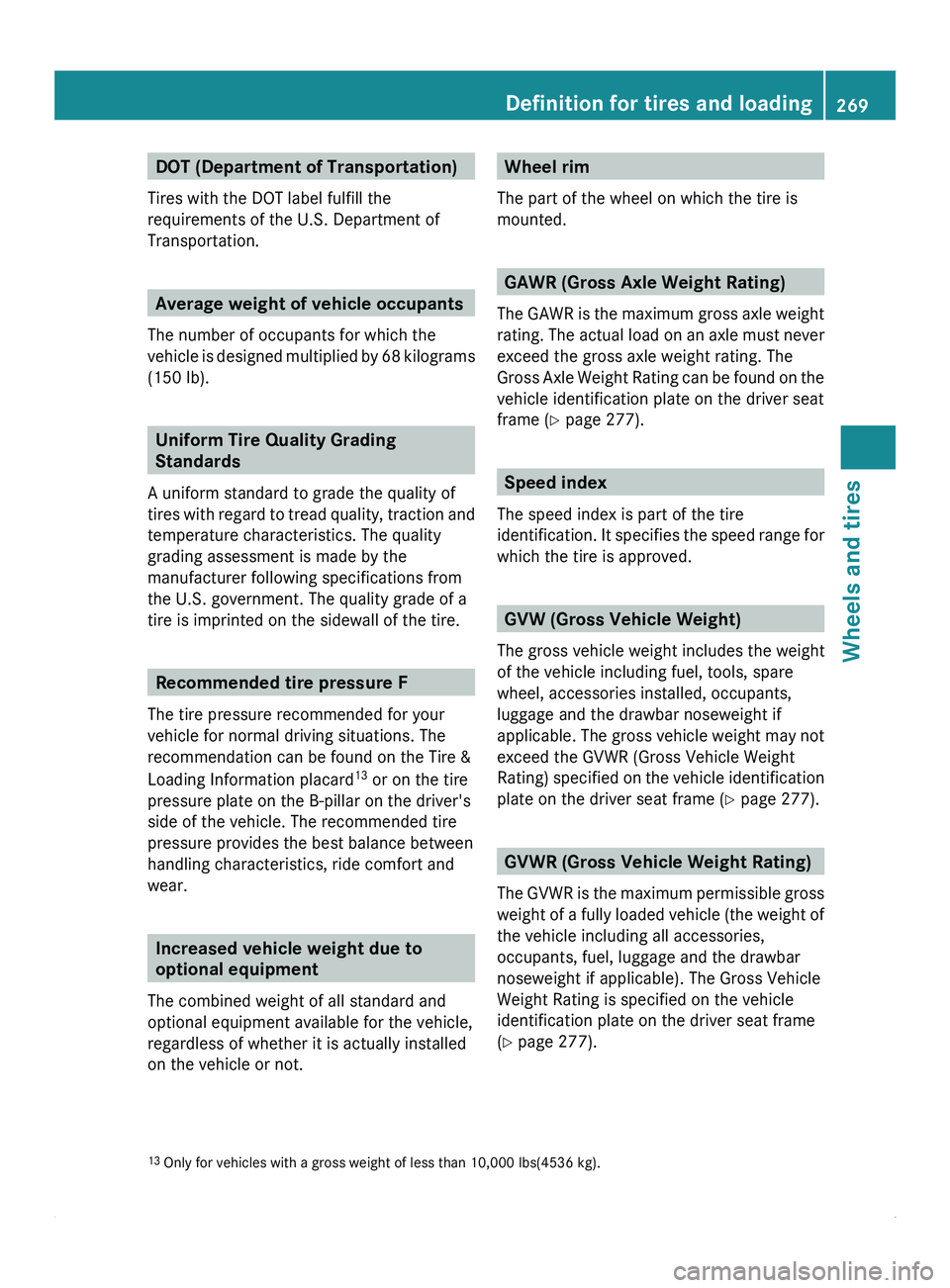
DOT (Department of Transportation)
Tires with the DOT label fulfill the
requirements of the U.S. Department of
Transportation. Average weight of vehicle occupants
The number of occupants for which the
vehicle is designed
multiplied by 68 kilograms
(150 lb). Uniform Tire Quality Grading
Standards
A uniform standard to grade the quality of
tires with regard
to tread quality, traction and
temperature characteristics. The quality
grading assessment is made by the
manufacturer following specifications from
the U.S. government. The quality grade of a
tire is imprinted on the sidewall of the tire. Recommended tire pressure F
The tire pressure recommended for your
vehicle for normal driving situations. The
recommendation can be found on the Tire &
Loading Information placard 13
or on the tire
pressure plate on the B-pillar on the driver's
side of the vehicle. The recommended tire
pressure provides the best balance between
handling characteristics, ride comfort and
wear. Increased vehicle weight due to
optional equipment
The combined weight of all standard and
optional equipment available for the vehicle,
regardless of whether it is actually installed
on the vehicle or not. Wheel rim
The part of the wheel on which the tire is
mounted. GAWR (Gross Axle Weight Rating)
The GAWR is
the maximum gross axle weight
rating. The actual load on an axle must never
exceed the gross axle weight rating. The
Gross Axle Weight Rating can be found on the
vehicle identification plate on the driver seat
frame (Y page 277). Speed index
The speed index is part of the tire
identification. It specifies
the speed range for
which the tire is approved. GVW (Gross Vehicle Weight)
The gross vehicle weight includes the weight
of the vehicle including fuel, tools, spare
wheel, accessories installed, occupants,
luggage and the drawbar noseweight if
applicable. The gross
vehicle weight may not
exceed the GVWR (Gross Vehicle Weight
Rating) specified on the vehicle identification
plate on the driver seat frame ( Y page 277). GVWR (Gross Vehicle Weight Rating)
The GVWR is
the maximum permissible gross
weight of a fully loaded vehicle (the weight of
the vehicle including all accessories,
occupants, fuel, luggage and the drawbar
noseweight if applicable). The Gross Vehicle
Weight Rating is specified on the vehicle
identification plate on the driver seat frame
(Y page 277).
13 Only for vehicles with a gross weight of less than 10,000 lbs(4536 kg). Definition for tires and loading
269
Wheels and tires Z
Page 272 of 292
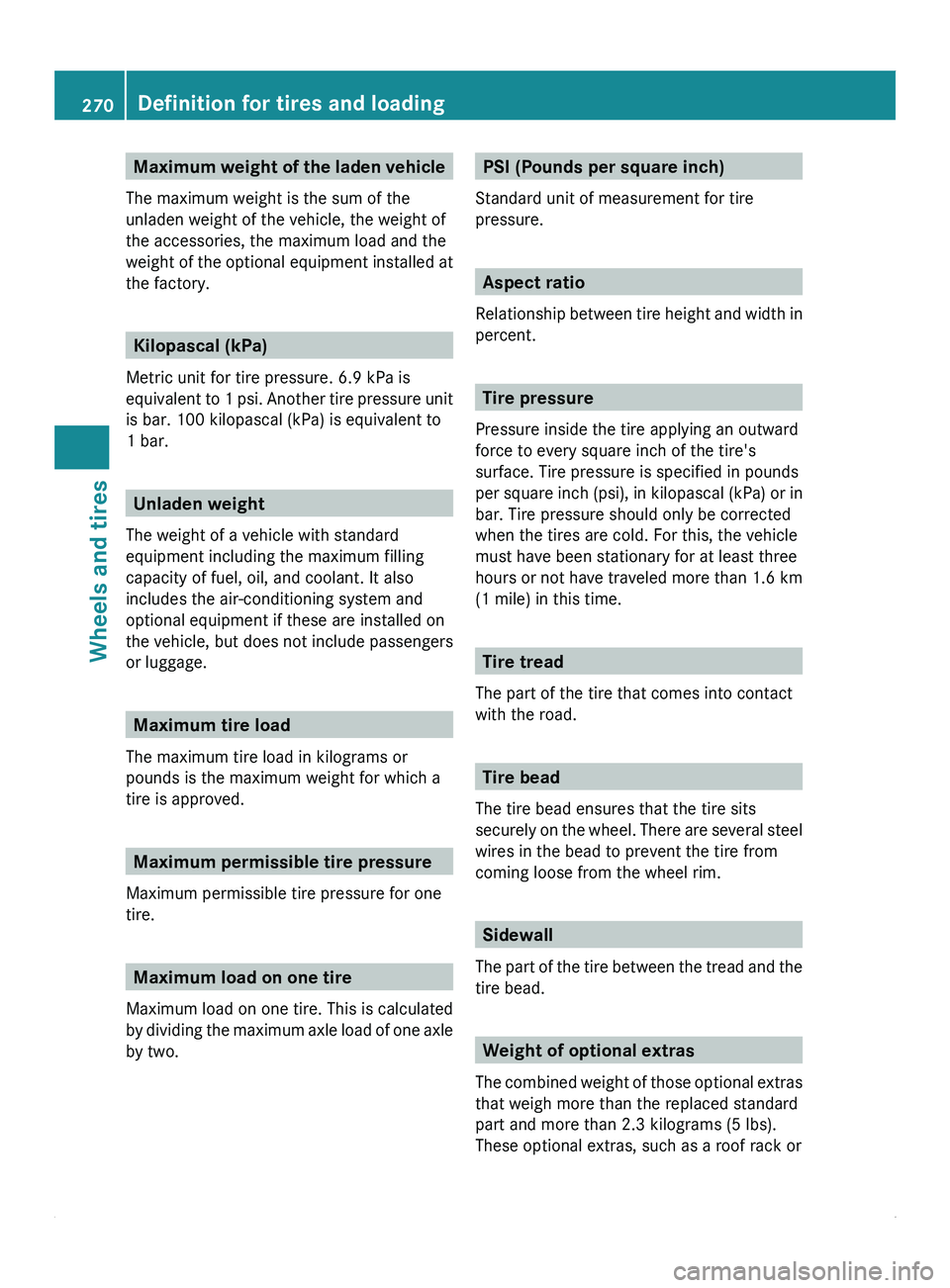
Maximum weight of the laden vehicle
The maximum weight is the sum of the
unladen weight of the vehicle, the weight of
the accessories, the maximum load and the
weight of the
optional equipment installed at
the factory. Kilopascal (kPa)
Metric unit for tire pressure. 6.9 kPa is
equivalent to
1 psi. Another tire pressure unit
is bar. 100 kilopascal (kPa) is equivalent to
1 bar. Unladen weight
The weight of a vehicle with standard
equipment including the maximum filling
capacity of fuel, oil, and coolant. It also
includes the air-conditioning system and
optional equipment if these are installed on
the vehicle, but does not include passengers
or luggage. Maximum tire load
The maximum tire load in kilograms or
pounds is the maximum weight for which a
tire is approved. Maximum permissible tire pressure
Maximum permissible tire pressure for one
tire. Maximum load on one tire
Maximum load on one tire. This is calculated
by dividing the
maximum axle load of one axle
by two. PSI (Pounds per square inch)
Standard unit of measurement for tire
pressure. Aspect ratio
Relationship between tire
height and width in
percent. Tire pressure
Pressure inside the tire applying an outward
force to every square inch of the tire's
surface. Tire pressure is specified in pounds
per square inch
(psi), in kilopascal (kPa) or in
bar. Tire pressure should only be corrected
when the tires are cold. For this, the vehicle
must have been stationary for at least three
hours or not have traveled more than 1.6 km
(1 mile) in this time. Tire tread
The part of the tire that comes into contact
with the road. Tire bead
The tire bead ensures that the tire sits
securely on the
wheel. There are several steel
wires in the bead to prevent the tire from
coming loose from the wheel rim. Sidewall
The part of
the tire between the tread and the
tire bead. Weight of optional extras
The combined weight
of those optional extras
that weigh more than the replaced standard
part and more than 2.3 kilograms (5 lbs).
These optional extras, such as a roof rack or 270
Definition for tires and loading
Wheels and tires
Page 273 of 292
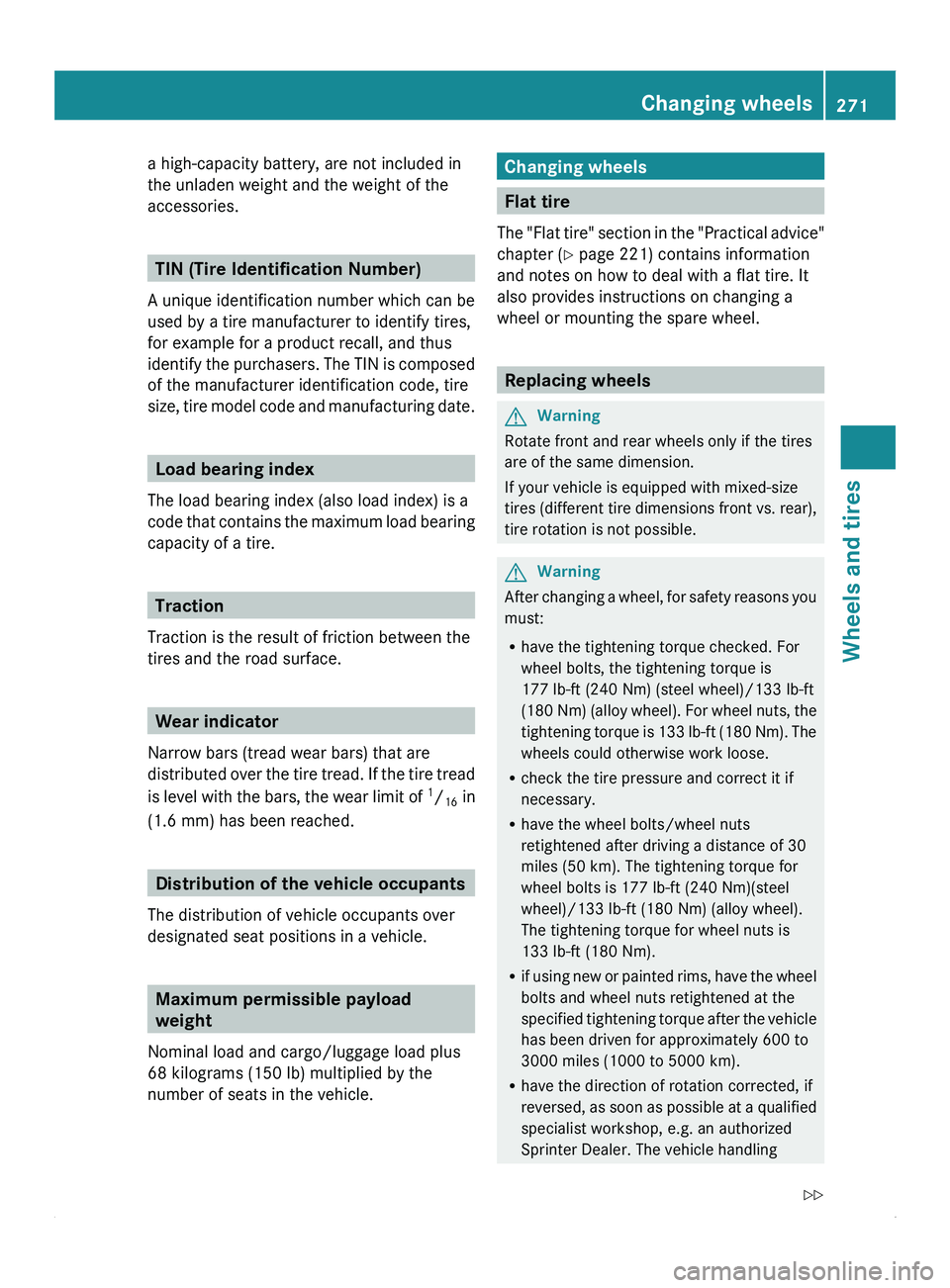
a high-capacity battery, are not included in
the unladen weight and the weight of the
accessories.
TIN (Tire Identification Number)
A unique identification number which can be
used by a tire manufacturer to identify tires,
for example for a product recall, and thus
identify the purchasers.
The TIN is composed
of the manufacturer identification code, tire
size, tire model code and manufacturing date. Load bearing index
The load bearing index (also load index) is a
code that contains
the maximum load bearing
capacity of a tire. Traction
Traction is the result of friction between the
tires and the road surface. Wear indicator
Narrow bars (tread wear bars) that are
distributed over the
tire tread. If the tire tread
is level with the bars, the wear limit of 1
/ 16 in
(1.6 mm) has been reached. Distribution of the vehicle occupants
The distribution of vehicle occupants over
designated seat positions in a vehicle. Maximum permissible payload
weight
Nominal load and cargo/luggage load plus
68 kilograms (150 lb) multiplied by the
number of seats in the vehicle. Changing wheels
Flat tire
The "Flat tire"
section in the "Practical advice"
chapter (Y page 221) contains information
and notes on how to deal with a flat tire. It
also provides instructions on changing a
wheel or mounting the spare wheel. Replacing wheels
G
Warning
Rotate front and rear wheels only if the tires
are of the same dimension.
If your vehicle is equipped with mixed-size
tires (different tire
dimensions front vs. rear),
tire rotation is not possible. G
Warning
After changing a wheel, for safety reasons you
must:
R have the tightening torque checked. For
wheel bolts, the tightening torque is
177 lb-ft (240 Nm) (steel wheel)/ 133 lb-ft
(180
Nm) (alloy wheel). For wheel nuts, the
tightening torque is 133 lb-ft (180 Nm). The
wheels could otherwise work loose.
R check the tire pressure and correct it if
necessary.
R have the wheel bolts/wheel nuts
retightened after driving a distance of 30
miles (50 km). The tightening torque for
wheel bolts is 177 lb-ft (240 Nm)(steel
wheel)/133 lb-ft (180 Nm) (alloy wheel).
The tightening torque for wheel nuts is
133 lb-ft (180 Nm).
R if using new or painted rims, have the wheel
bolts and wheel nuts retightened at the
specified tightening torque after the vehicle
has been driven for approximately 600 to
3000 miles (1000 to 5000 km).
R have the direction of rotation corrected, if
reversed, as soon as possible at a qualified
specialist workshop, e.g. an authorized
Sprinter Dealer. The vehicle handling Changing wheels
271
Wheels and tires
Z
Page 274 of 292
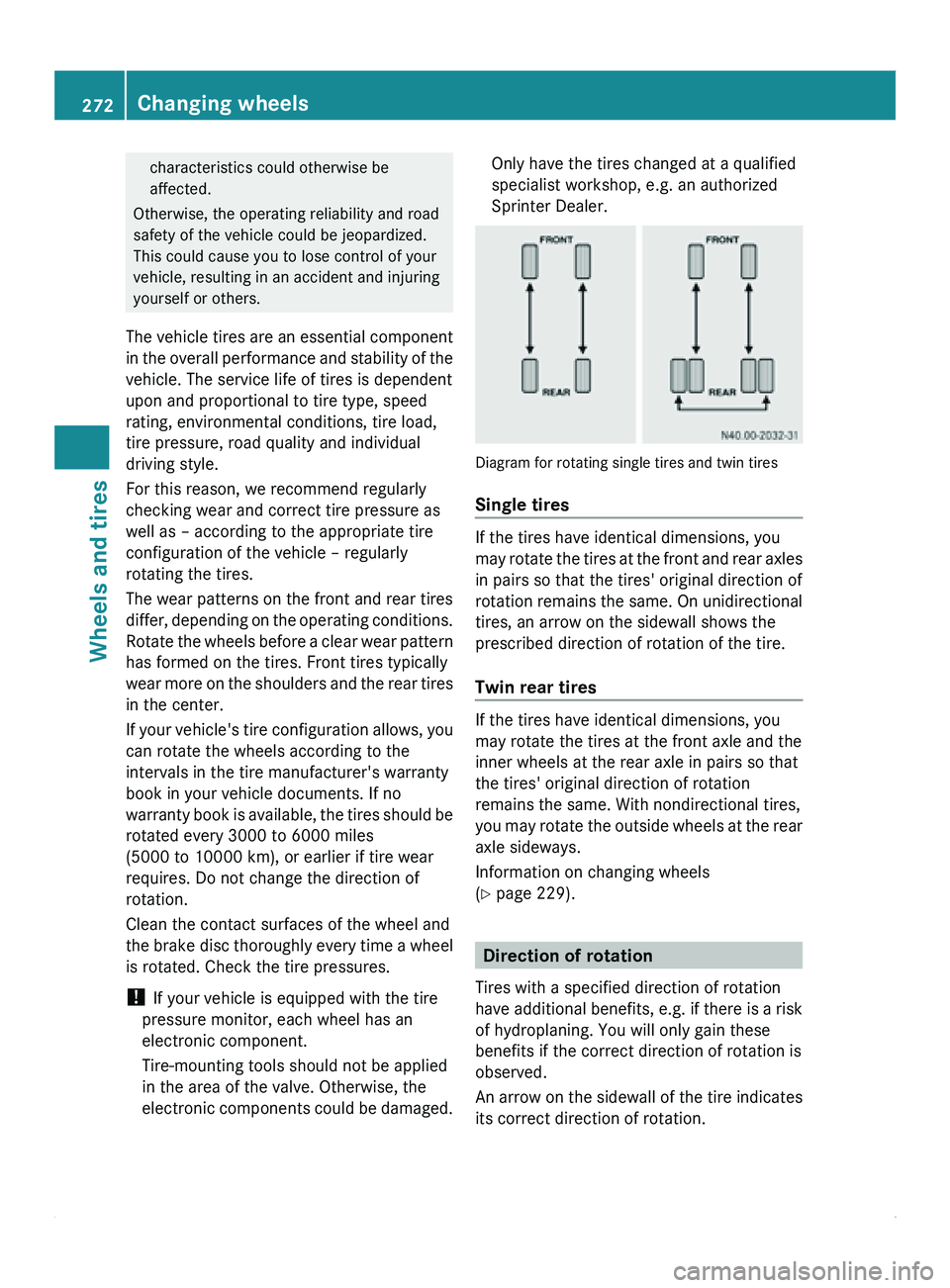
characteristics could otherwise be
affected.
Otherwise, the operating reliability and road
safety of the vehicle could be jeopardized.
This could cause you to lose control of your
vehicle, resulting in an accident and injuring
yourself or others.
The vehicle tires
are an essential component
in the overall performance and stability of the
vehicle. The service life of tires is dependent
upon and proportional to tire type, speed
rating, environmental conditions, tire load,
tire pressure, road quality and individual
driving style.
For this reason, we recommend regularly
checking wear and correct tire pressure as
well as – according to the appropriate tire
configuration of the vehicle – regularly
rotating the tires.
The wear patterns on the front and rear tires
differ, depending on the operating conditions.
Rotate the wheels before a clear wear pattern
has formed on the tires. Front tires typically
wear more on the shoulders and the rear tires
in the center.
If your vehicle's tire configuration allows, you
can rotate the wheels according to the
intervals in the tire manufacturer's warranty
book in your vehicle documents. If no
warranty book is available, the tires should be
rotated every 3000 to 6000 miles
(5000 to 10000 km), or earlier if tire wear
requires. Do not change the direction of
rotation.
Clean the contact surfaces of the wheel and
the brake disc thoroughly every time a wheel
is rotated. Check the tire pressures.
! If your vehicle is equipped with the tire
pressure monitor, each wheel has an
electronic component.
Tire-mounting tools should not be applied
in the area of the valve. Otherwise, the
electronic components could be damaged. Only have the tires changed at a qualified
specialist workshop, e.g. an authorized
Sprinter Dealer.
Diagram for rotating single tires and twin tires
Single tires
If the tires have identical dimensions, you
may rotate
the
tires at the front and rear axles
in pairs so that the tires' original direction of
rotation remains the same. On unidirectional
tires, an arrow on the sidewall shows the
prescribed direction of rotation of the tire.
Twin rear tires If the tires have identical dimensions, you
may rotate the tires at the front axle and the
inner wheels at the rear axle in pairs so that
the tires' original direction of rotation
remains the same. With nondirectional tires,
you may
rotate
the outside wheels at the rear
axle sideways.
Information on changing wheels
(Y page 229). Direction of rotation
Tires with a specified direction of rotation
have
additional benefits,
e.g. if there is a risk
of hydroplaning. You will only gain these
benefits if the correct direction of rotation is
observed.
An arrow on the sidewall of the tire indicates
its correct direction of rotation. 272
Changing wheels
Wheels and tires
Page 275 of 292
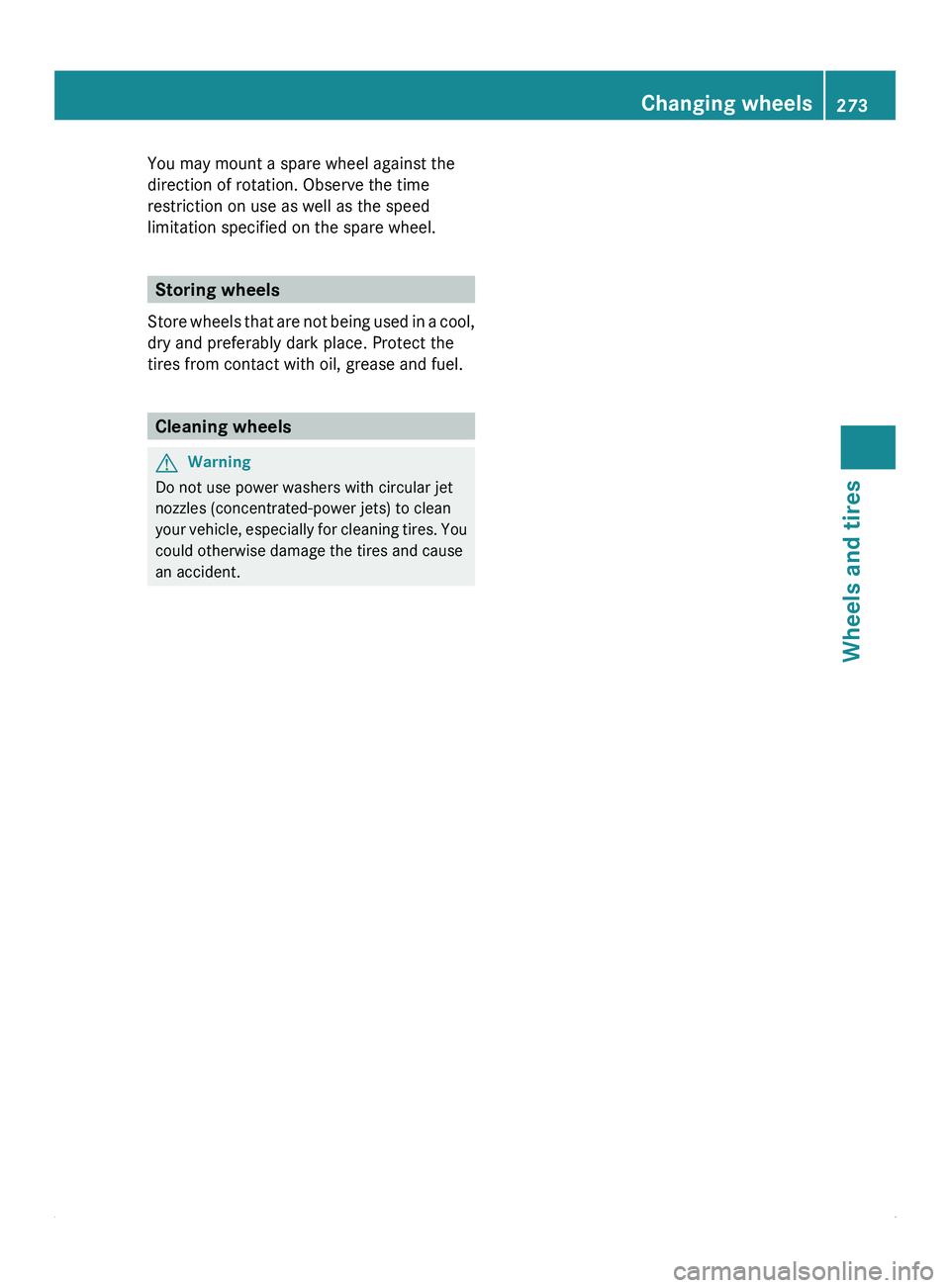
You may mount a spare wheel against the
direction of rotation. Observe the time
restriction on use as well as the speed
limitation specified on the spare wheel.
Storing wheels
Store wheels that
are not being used in a cool,
dry and preferably dark place. Protect the
tires from contact with oil, grease and fuel. Cleaning wheels
G
Warning
Do not use power washers with circular jet
nozzles (concentrated-power jets) to clean
your vehicle, especially
for cleaning tires. You
could otherwise damage the tires and cause
an accident. Changing wheels
273
Wheels and tires Z
Page 276 of 292

274
Page 277 of 292
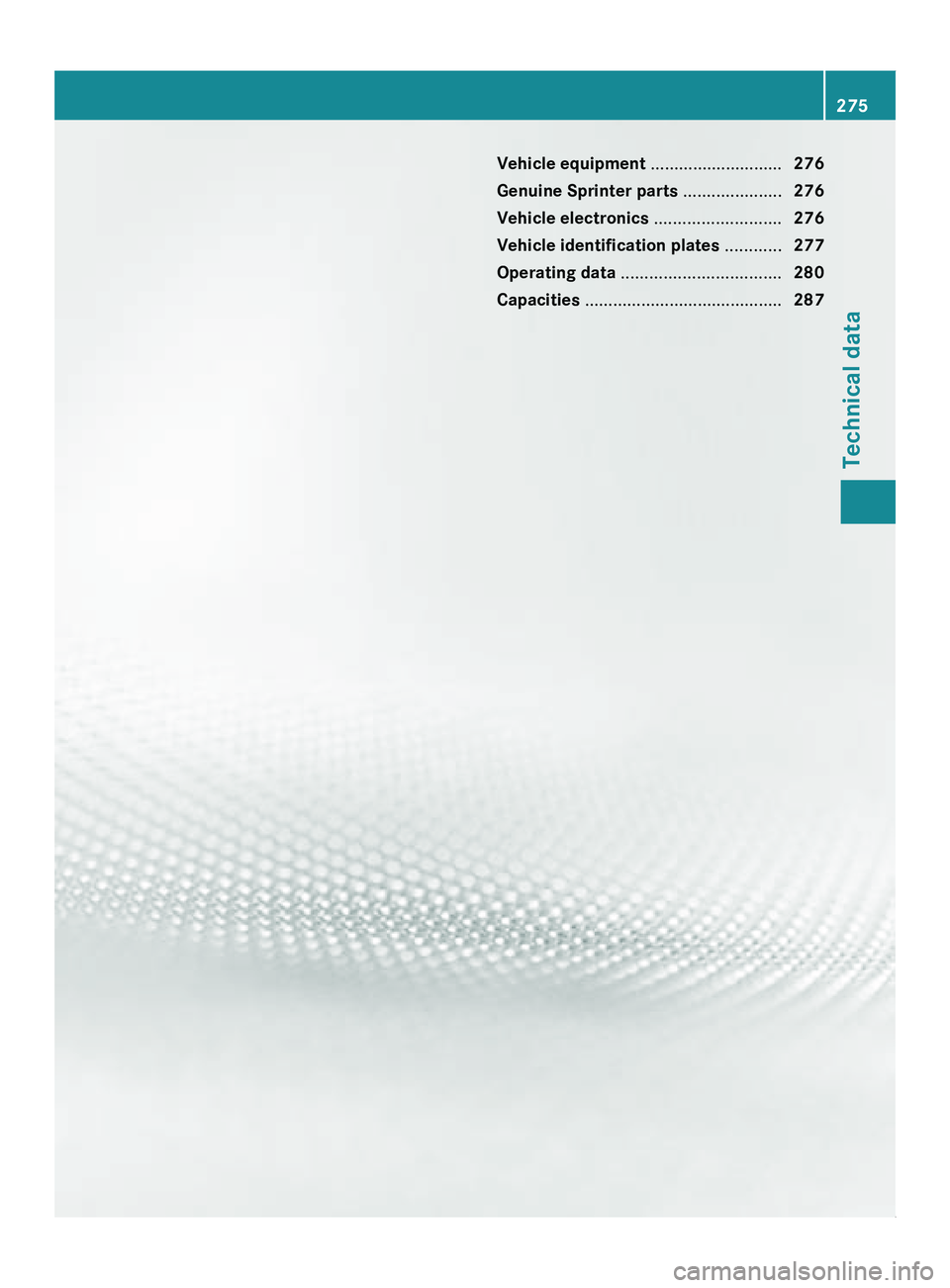
Vehicle equipment ............................
276
Genuine Sprinter parts .....................276
Vehicle electronics ...........................276
Vehicle identification plates ............277
Operating data .................................. 280
Capacities .......................................... 287 275Technical data
Page 278 of 292
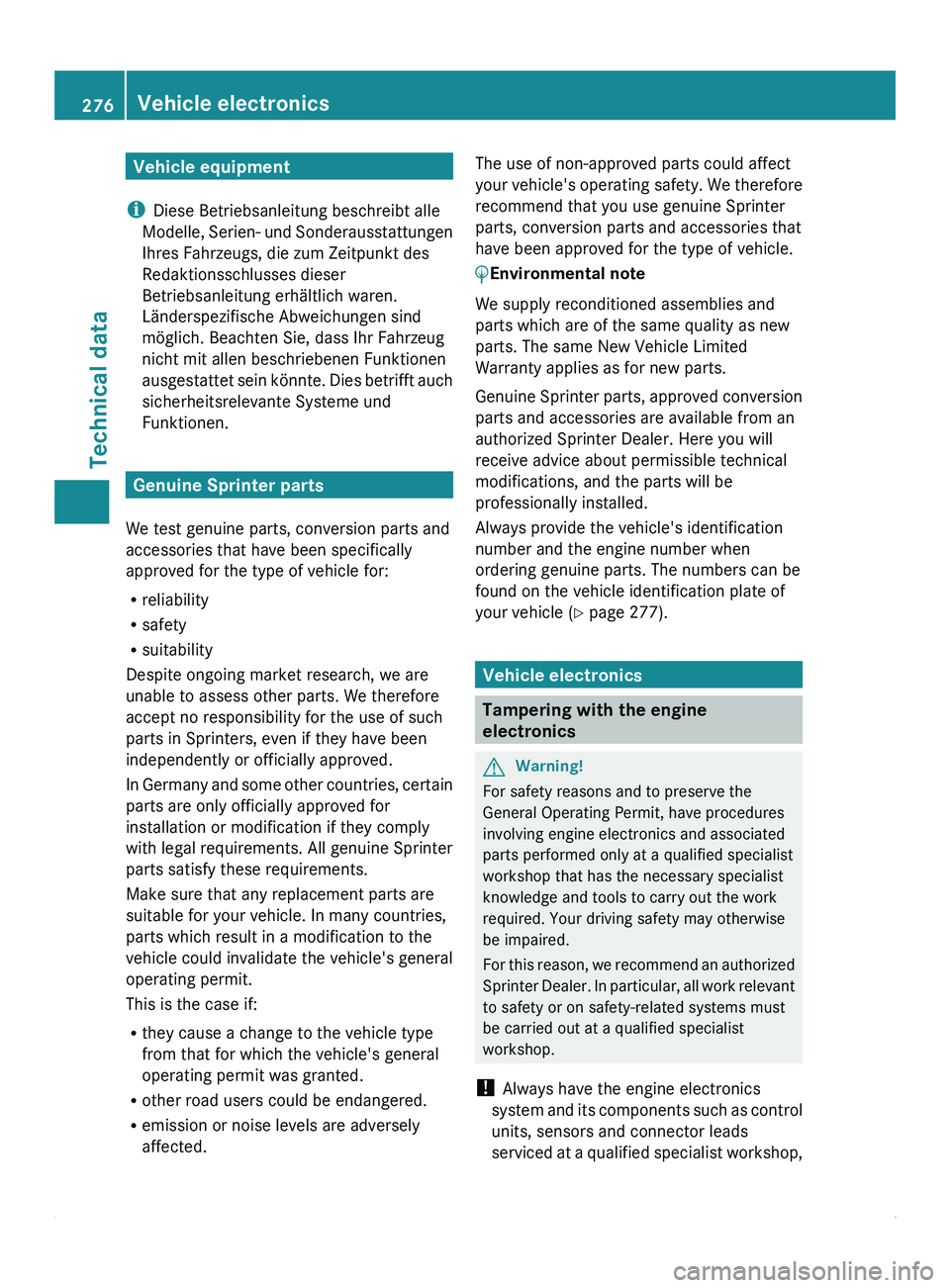
Vehicle equipment
i Diese Betriebsanleitung beschreibt alle
Modelle, Serien- und
Sonderausstattungen
Ihres Fahrzeugs, die zum Zeitpunkt des
Redaktionsschlusses dieser
Betriebsanleitung erhältlich waren.
Länderspezifische Abweichungen sind
möglich. Beachten Sie, dass Ihr Fahrzeug
nicht mit allen beschriebenen Funktionen
ausgestattet sein könnte. Dies betrifft auch
sicherheitsrelevante Systeme und
Funktionen. Genuine Sprinter parts
We test genuine parts, conversion parts and
accessories that have been specifically
approved for the type of vehicle for:
R reliability
R safety
R suitability
Despite ongoing market research, we are
unable to assess other parts. We therefore
accept no responsibility for the use of such
parts in Sprinters, even if they have been
independently or officially approved.
In Germany and
some other countries, certain
parts are only officially approved for
installation or modification if they comply
with legal requirements. All genuine Sprinter
parts satisfy these requirements.
Make sure that any replacement parts are
suitable for your vehicle. In many countries,
parts which result in a modification to the
vehicle could invalidate the vehicle's general
operating permit.
This is the case if:
R they cause a change to the vehicle type
from that for which the vehicle's general
operating permit was granted.
R other road users could be endangered.
R emission or noise levels are adversely
affected. The use of non-approved parts could affect
your vehicle's
operating
safety. We therefore
recommend that you use genuine Sprinter
parts, conversion parts and accessories that
have been approved for the type of vehicle.
0040Environmental note
We supply reconditioned assemblies and
parts which are of the same quality as new
parts. The same New Vehicle Limited
Warranty applies as for new parts.
Genuine Sprinter parts, approved conversion
parts and accessories are available from an
authorized Sprinter Dealer. Here you will
receive advice about permissible technical
modifications, and the parts will be
professionally installed.
Always provide the vehicle's identification
number and the engine number when
ordering genuine parts. The numbers can be
found on the vehicle identification plate of
your vehicle ( Y page 277). Vehicle electronics
Tampering with the engine
electronics
G
Warning!
For safety reasons and to preserve the
General Operating Permit, have procedures
involving engine electronics and associated
parts performed only at a qualified specialist
workshop that has the necessary specialist
knowledge and tools to carry out the work
required. Your driving safety may otherwise
be impaired.
For this reason,
we recommend an authorized
Sprinter Dealer. In particular, all work relevant
to safety or on safety-related systems must
be carried out at a qualified specialist
workshop.
! Always have the engine electronics
system and its components such as control
units, sensors and connector leads
serviced at a qualified specialist workshop, 276
Vehicle electronics
Technical data
Page 279 of 292
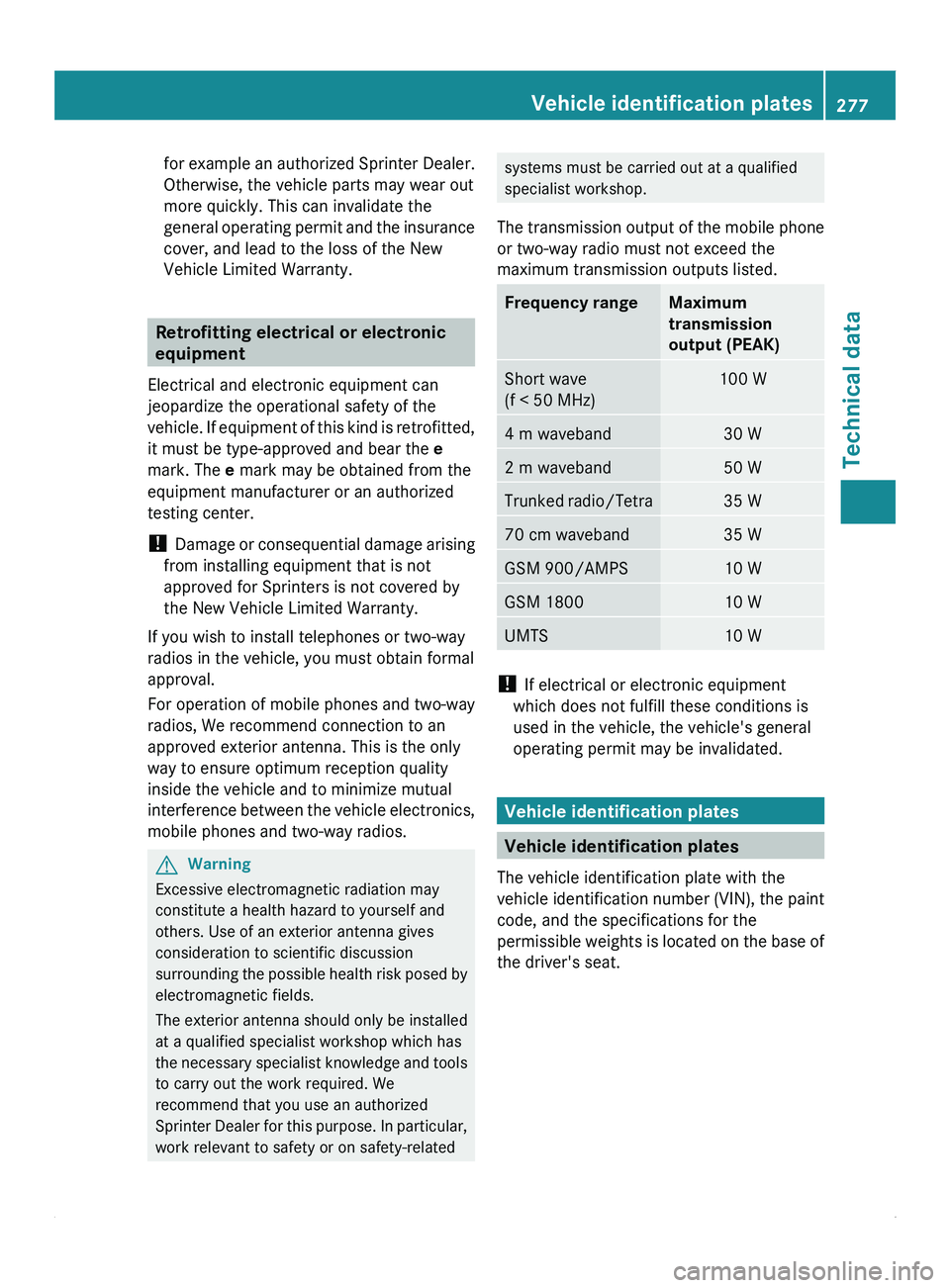
for example an authorized Sprinter Dealer.
Otherwise, the vehicle parts may wear out
more quickly. This can invalidate the
general operating
permit
and the insurance
cover, and lead to the loss of the New
Vehicle Limited Warranty. Retrofitting electrical or electronic
equipment
Electrical and electronic equipment can
jeopardize the operational safety of the
vehicle. If equipment
of this kind is retrofitted,
it must be type-approved and bear the e
mark. The e mark may be obtained from the
equipment manufacturer or an authorized
testing center.
! Damage or consequential damage arising
from installing equipment that is not
approved for Sprinters is not covered by
the New Vehicle Limited Warranty.
If you wish to install telephones or two-way
radios in the vehicle, you must obtain formal
approval.
For operation of mobile phones and two-way
radios, We recommend connection to an
approved exterior antenna. This is the only
way to ensure optimum reception quality
inside the vehicle and to minimize mutual
interference between the vehicle electronics,
mobile phones and two-way radios. G
Warning
Excessive electromagnetic radiation may
constitute a health hazard to yourself and
others. Use of an exterior antenna gives
consideration to scientific discussion
surrounding the possible
health risk posed by
electromagnetic fields.
The exterior antenna should only be installed
at a qualified specialist workshop which has
the necessary specialist knowledge and tools
to carry out the work required. We
recommend that you use an authorized
Sprinter Dealer for this purpose. In particular,
work relevant to safety or on safety-related systems must be carried out at a qualified
specialist workshop.
The transmission output
of the mobile phone
or two-way radio must not exceed the
maximum transmission outputs listed. Frequency range Maximum
transmission
output (PEAK)
Short wave
(f < 50 MHz) 100 W
4 m waveband 30 W
2 m waveband 50 W
Trunked radio/Tetra 35 W
70 cm waveband 35 W
GSM 900/AMPS 10 W
GSM 1800 10 W
UMTS 10 W
!
If electrical or electronic equipment
which does not fulfill these conditions is
used in the vehicle, the vehicle's general
operating permit may be invalidated. Vehicle identification plates
Vehicle identification plates
The vehicle identification plate with the
vehicle identification number
(VIN), the paint
code, and the specifications for the
permissible weights is located on the base of
the driver's seat. Vehicle identification plates
277
Technical data Z
Page 280 of 292
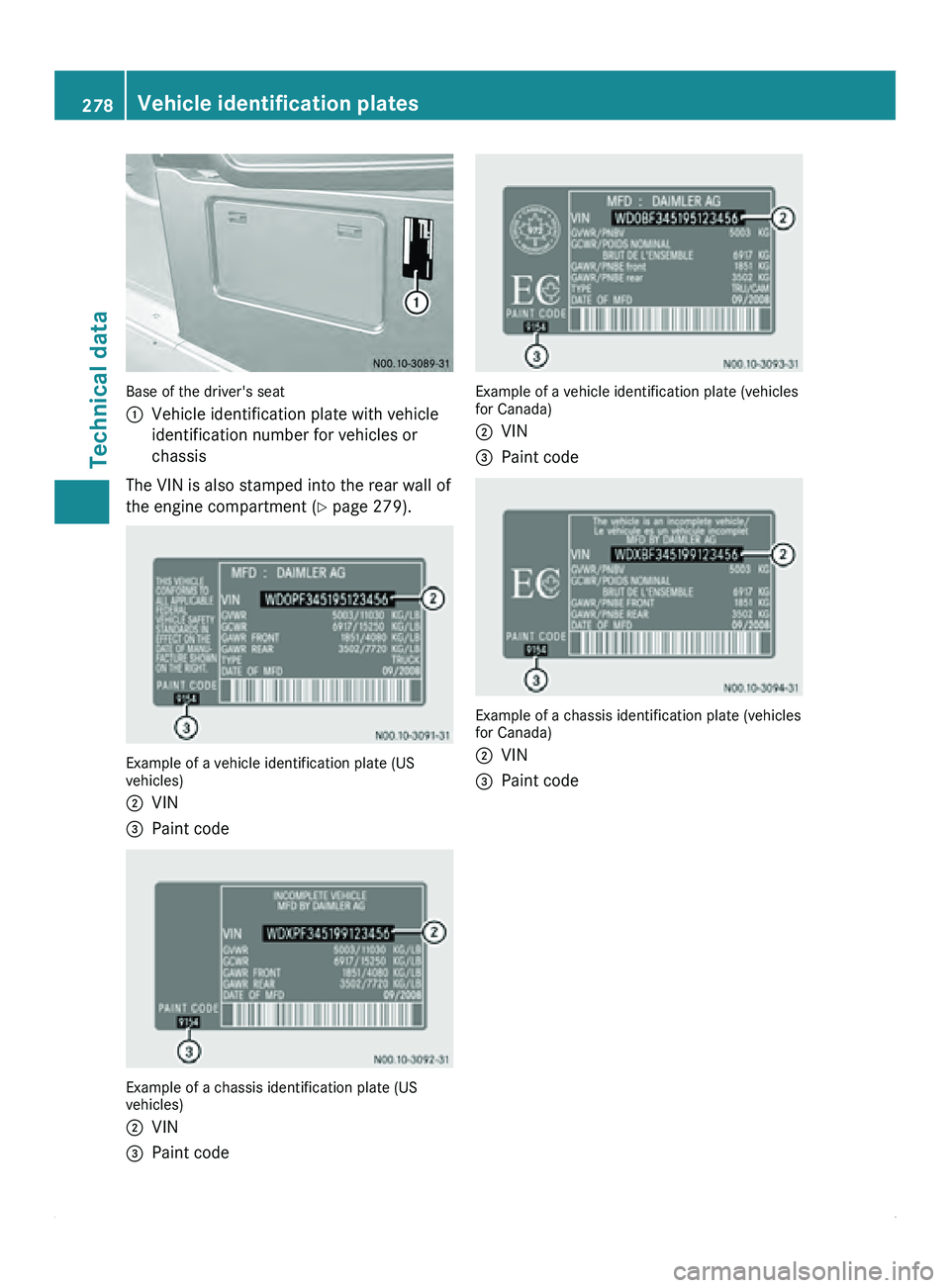
Base of the driver's seat
0046
Vehicle identification plate with vehicle
identification number for vehicles or
chassis
The VIN is also stamped into the rear wall of
the engine compartment ( Y page 279). Example of a vehicle identification plate (US
vehicles)
0047
VIN
008A Paint code Example of a chassis identification plate (US
vehicles)
0047
VIN
008A Paint code Example of a vehicle identification plate (vehicles
for Canada)
0047
VIN
008A Paint code Example of a chassis identification plate (vehicles
for Canada)
0047
VIN
008A Paint code278
Vehicle identification platesTechnical data